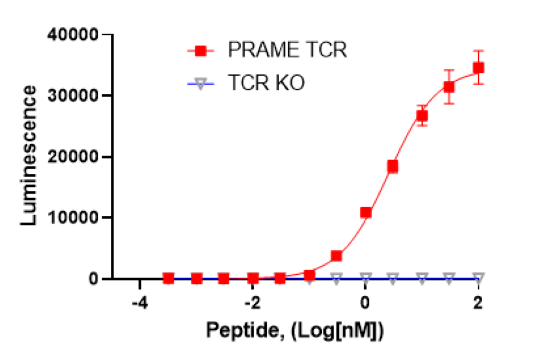PRAME TCR CD8+ NFAT-Luciferase Reporter Jurkat Cell Line
PRAME TCR CD8+ NFAT-Luciferase Reporter Jurkat Cell Line was generated from T Cell Receptor (TCR) Knockout NFAT Luciferase Reporter Jurkat Cell Line (BPS Bioscience #78556) by overexpression of human CD8 (NM_001768.6) and a PRAME (Preferentially Expressed Antigen in Melanoma)-directed TCR using lentiviral transduction (CD8a Lentivirus #78648 and PRAME-Specific TCR Lentivirus #78959). This PRAME TCR specifically recognizes an antigen PRAME peptide, amino acids peptide 425-433 (SLLQHLIGL).

Figure 1: Illustration of the functional co-culture assay used to validate the PRAME TCR CD8+ NFAT-Luciferase Reporter Jurkat Cell Line.
Purchase of this cell line is for research purposes only; commercial use requires a separate license. View the full terms and conditions.
| Name | Ordering Information |
| Thaw Medium 2 | BPS Bioscience #60184 |
| Growth Medium 2T | BPS Bioscience #78756 |
| Assay Medium 2D | BPS Bioscience #78755 |
| CD8+ TCR Knockout NFAT-Luciferase Reporter Jurkat Cell Line | BPS Bioscience #78757 |
| T2 Cell Line | ATCC #CRL-1992 |
| PRAME Peptide (425-433) | BPS Bioscience #78991 |
| PE anti-human α/β T Cell Receptor Antibody | BioLegend #306707 |
| ONE-Step™ Luciferase Assay System | BPS Bioscience #60690 |
| 96-well tissue culture plate, white, clear bottom |
The cell line has been screened to confirm the absence of Mycoplasma species.
PRAME (Preferentially Expressed Antigen in Melanoma) is a protein with a profile of expression in normal tissues highly restricted to testis, ovarium, and endometrium. However, it is found at high levels in several cancer types, such as melanoma, breast, and lung cancer. It is also found in cells of patients with AML (acute myeloid leukemia) and Hodgkin’s lymphoma. Overexpression seems to block retinoic acid (RA)-mediated cell proliferation, differentiation, and apoptosis, contributing to tumorigenesis. Its expression pattern makes it an attractive target for immunotherapy. It is a membrane-bound protein, and it is thus a good target for TCR (T cell receptor)-T cells and anti-PRAME vaccines. Several clinical trials are ongoing and have demonstrated the clinical potential of targeting PRAME in melanoma, lung cancer and other solid tumors. Further studies into the functions of this protein will bring new clinical advances in cancer therapy.
CD8 (Cluster of Differentiation 8) is a co-receptor of TCR and a typical marker of cytotoxic T cells. The TCR protein complex is found on the surface of T cells and is responsible for recognizing antigens bound to MHC (Major Histocompatibility Complex) molecules. Stimulation of the TCR results in activation of downstream NFAT (Nuclear factor of Activated T-cells) transcription factors that induce the expression of various cytokines such as interleukin-2 to 4, and TNF-alpha. The use of engineered TCR allows T cells to target specific antigens present in cancer cells via the MHC, expanding the portfolio of antigens that can be targeted in cancer cell therapy.
Xu Y., et al., 2020 Cell Prolif. 53(3):e12770.



